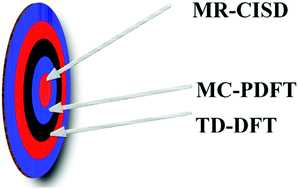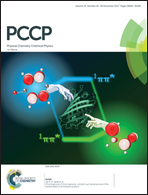Multiconfiguration pair-density functional theory for doublet excitation energies and excited state geometries: the excited states of CN†
Abstract
Multiconfiguration pair-density functional theory (MC-PDFT) is a post multiconfiguration self-consistent field (MCSCF) method with similar performance to complete active space second-order perturbation theory (CASPT2) but with greater computational efficiency. Cyano radical (CN) is a molecule whose spectrum is well established from experiments and whose excitation energies have been used as a testing ground for theoretical methods to treat excited states of open-shell systems, which are harder and much less studied than excitation energies of closed-shell singlets. In the present work, we studied the adiabatic excitation energies of CN with MC-PDFT. Then we compared this multireference (MR) method to some single-reference (SR) methods, including time-dependent density functional theory (TDDFT) and completely renormalized equation-of-motion coupled-cluster theory with singles, doubles and noniterative triples [CR-EOM-CCSD(T)]; we also compared to some other MR methods, including configuration interaction singles and doubles (MR-CISD) and multistate CASPT2 (MS-CASPT2). Through a comparison between SR and MR methods, we achieved a better appreciation of the need to use MR methods to accurately describe higher excited states, and we found that among the MR methods, MC-PDFT stands out for its accuracy for the first four states out of the five doublet states studied this paper; this shows its efficiency for calculating doublet excited states.



 Please wait while we load your content...
Please wait while we load your content...